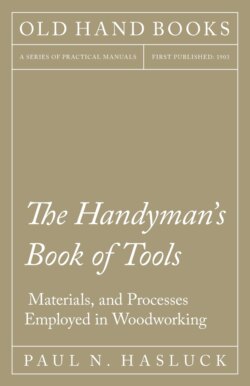Читать книгу The Handyman's Book of Tools, Materials, and Processes Employed in Woodworking - Paul N. Hasluck - Страница 38
На сайте Литреса книга снята с продажи.
IMPROVED BENCH SCREW VICE.
ОглавлениеThe defects of the old-fashioned form of bench vice shown by Fig. 92 may be noted. Suppose it is required to hold a door rail whilst tenons are cut, a piece of stuff of the exact thickness of the rail has to be inserted between the jaw and the bench at the opposite end to that in which the door rail is put, and, should the piece inserted be a trifle thicker or thinner than the rail, difficulty will be experienced in tightening the screw sufficiently to keep the rail rigid whilst cutting the tenon, and even then it will probably slip about and become loose. If it is required to plough, say, the edge of a mullion, when this is placed in the screw and tightened up the jaw tilts over as shown in Fig. 93 and grips the mullion hard on its two arrises; and in fixing it in the vice in order to plough the second edge, great care must be exercised to avoid splitting off pieces from the rail at each side of the groove, and thus disfiguring the work, and there are other disadvantages. An improvement on the old form is suggested by Figs. 94 and 95. Instead of having the jaw horizontal, the idea is to adjust it in a raking position; it will then grip the work on both sides of the screw, instead of only on one side as formerly, thus avoiding the tilt; and this advantage is assured whether the work be placed in the vice vertically, horizontally, or obliquely. There is another good point in this arrangement—namely, the rail mortised into the jaw at its lower end may fit rather loosely in the socket screwed on to the bench leg. Holes are bored through this rail at certain distances apart, and in any one of these a pin is inserted. This pin answers the purpose of the blocks placed between the jaw and the bench when the vice is horizontal, with the advantage that, no matter in which of the holes the pin is placed, the vice will grip two or three thicknesses of stuff, thus avoiding the necessity of providing a new block every time work of a different thickness is put into the vice. With this newer form of vice the work can be held securely and satisfactorily by about a quarter turn of the screw. Iron vices for joiners can, of course, be obtained, and against these nothing is urged but their price, which is prohibitive to a great many. The arrangement here advocated is therefore confidently recommended as being at once inexpensive to construct and thoroughly efficient in use.
Fig. 90.—Inside View of Screw Vice.
Fig. 91.—Section through Screw Vice.
Figs. 92 and 93.—Ordinary Screw Vice and its Defect.
Figs. 94 and 95.—Improved Bench Vice.
Fig. 96.—Instantaneous Grip Vice.
